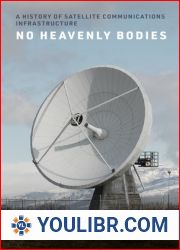
BOOKS - TECHNICAL SCIENCES - No Heavenly Bodies A History of Satellite Communications...

No Heavenly Bodies A History of Satellite Communications Infrastructure
Author: Christine E. Evans, Lars Lundgren
Year: 2023
Format: PDF
File size: 10,9 MB
Language: ENG

Year: 2023
Format: PDF
File size: 10,9 MB
Language: ENG

beginning with the launch of the world's first artificial satellite Sputnik 1 by the Soviet Union in 1957 and ending with the collapse of the Soviet bloc in 1989. The book provides a comprehensive narrative of how the geopolitical tensions of the Cold War influenced the development of satellite communications and telecommunications technologies in the Eastern Bloc countries of Europe including Poland, East Germany, Czechoslovakia, and Hungary. It also examines how the West exploited the division of postwar Europe to advance their interests and deepen their own involvement in space research and technology. The book argues that satellite communications played a crucial role in bridging the gap between the Western and Eastern Blocs through the decades long arms race fueled by the Cold War. No Heavenly Bodies A History of Satellite Communications Infrastructure is a fascinating account of the development of satellite communications technology during the Cold War era. The book delves into the little-known history of the Soviet and Eastern European contributions to this field, providing a comprehensive narrative of how geopolitical tensions shaped the evolution of satellite communications and telecommunications technologies. The author highlights how the West exploited the division of post-war Europe to further their own interests in space research and technology, while satellite communications played a critical role in bridging the gap between the Western and Eastern Blocs. The book begins with the launch of Sputnik 1 by the Soviet Union in 1957, marking the dawn of artificial satellite technology.
, начиная с запуска Советским Союзом первого в мире искусственного спутника Спутник-1 в 1957 году и заканчивая распадом советского блока в 1989 году. В книге содержится исчерпывающая информация о том, как геополитическая напряженность холодной войны повлияла на развитие спутниковая связь и телекоммуникационные технологии в странах Восточного блока Европы, включая Польшу, Восточная Германия, Чехословакия и Венгрия. В нем также рассматривается, как Запад использовал разделение послевоенной Европы для продвижения своих интересов и углубления собственного участия в космических исследованиях и технологиях. В книге утверждается, что спутниковая связь сыграла решающую роль в преодолении разрыва между Западным и Восточным блоками в результате многолетней гонки вооружений, вызванной холодной войны.Нет небесных тел История инфраструктуры спутниковой связи - увлекательный рассказ о развитии технологий спутниковой связи в эпоху холодной войны. Книга углубляется в малоизвестную историю советского и восточноевропейского вклада в эту область, предоставляя исчерпывающее повествование о том, как геополитическая напряженность сформировала эволюцию спутниковой связи и телекоммуникационных технологий. Автор подчеркивает, как Запад использовал разделение послевоенной Европы для продвижения собственных интересов в области космических исследований и технологий, в то время как спутниковая связь сыграла решающую роль в преодолении разрыва между Западным и Восточным блоками Книга начинается с запуска Советским Союзом Спутника-1 в 1957 году, знаменуя собой рассвет технологии искусственных спутников.
, depuis le lancement par l'Union soviétique du premier satellite artificiel Sputnik-1 au monde en 1957 jusqu'à l'effondrement du bloc soviétique en 1989. livre fournit des informations détaillées sur la façon dont les tensions géopolitiques de la guerre froide ont influencé le développement des communications par satellite et des technologies de télécommunications dans les pays du bloc Est de l'Europe, y compris la Pologne, l'Allemagne de l'Est, la Tchécoslovaquie et la Hongrie. Il examine également comment l'Occident a utilisé la division de l'Europe d'après-guerre pour promouvoir ses intérêts et approfondir sa propre participation à la recherche et à la technologie spatiales. livre affirme que les communications par satellite ont joué un rôle crucial pour combler le fossé entre les blocs de l'Ouest et de l'Est à la suite de nombreuses années de course aux armements déclenchées par la guerre froide. Pas de corps célestes L'histoire de l'infrastructure des communications par satellite est une histoire fascinante sur le développement des technologies de communication par satellite à l'époque de la guerre froide. livre explore l'histoire peu connue des contributions soviétiques et de l'Europe de l'Est dans ce domaine, en fournissant un récit exhaustif de la façon dont les tensions géopolitiques ont façonné l'évolution des communications par satellite et des technologies de télécommunications. L'auteur souligne, comme l'Ouest utilisait la division de l'Europe d'après-guerre pour la progression des intérêts personnels dans le domaine des études spatiales et les technologies, pendant que la liaison par satellite a joué le rôle décisif dans l'élimination de la rupture entre Occidental et Oriental le Livre commence par les blocs par la mise en marche par l'Union Soviétique Spoutnika-1 en 1957, en marquant lui-même l'aube de la technologie des spoutniks.
, desde el lanzamiento del primer satélite artificial Sputnik-1 del mundo por la Unión Soviética en 1957 hasta el colapso del bloque soviético en 1989. libro contiene información exhaustiva sobre cómo las tensiones geopolíticas de la Guerra Fría afectaron el desarrollo de las comunicaciones por satélite y las tecnologías de telecomunicaciones en los países del Bloque Oriental de , incluyendo Polonia, Alemania Oriental, Checoslovaquia y Hungría. También examina cómo Occidente utilizó la división de la de la posguerra para promover sus intereses y profundizar su propia participación en la investigación y la tecnología espaciales. libro sostiene que las comunicaciones por satélite jugaron un papel crucial para cerrar la brecha entre los bloques Oeste y Este como resultado de los de carrera armamentista provocados por la Guerra Fría. No hay cuerpos celestes La historia de la infraestructura de comunicaciones por satélite es una historia fascinante sobre el desarrollo de la tecnología de comunicaciones por satélite en la era de la Guerra Fría. libro profundiza en la historia poco conocida de las contribuciones soviéticas y del este de en este campo, proporcionando una narrativa exhaustiva de cómo las tensiones geopolíticas han moldeado la evolución de las comunicaciones por satélite y las tecnologías de telecomunicaciones. autor destaca cómo Occidente utilizó la división de la de la posguerra para promover sus propios intereses en la investigación espacial y la tecnología, mientras que las comunicaciones por satélite jugaron un papel crucial para salvar la brecha entre los bloques Oeste y Este libro comienza con el lanzamiento de Sputnik-1 por la Unión Soviética en 1957, marcando el amanecer de la tecnología de satélites artificiales.
, desde o lançamento, pela União Soviética, do primeiro satélite artificial do mundo, o Sputnik-1, em 1957, até a desintegração do bloco soviético, em 1989. O livro traz informações completas sobre como as tensões geopolíticas da Guerra Fria afetaram o desenvolvimento das comunicações por satélite e das tecnologias de telecomunicações nos países do Bloco de ste da , incluindo Polônia, Alemanha Oriental, Checoslováquia e Hungria. Ele também considera como o Ocidente usou a divisão da pós-guerra para promover seus interesses e aprofundar sua própria participação na exploração e tecnologia espaciais. O livro afirma que as comunicações por satélite foram cruciais para superar o fosso entre os blocos Ocidental e Oriental, como resultado de anos de corrida armamentista provocada pela Guerra Fria. Não há corpos celestes A história da infraestrutura de comunicações por satélite é uma história fascinante sobre o desenvolvimento das tecnologias de comunicações por satélite durante a Guerra Fria. O livro aprofundou-se na história pouco conhecida das contribuições soviéticas e da oriental, fornecendo uma narrativa abrangente de como as tensões geopolíticas moldaram a evolução das comunicações por satélite e das tecnologias de telecomunicações. O autor enfatiza como o Ocidente usou a divisão da pós-guerra para promover seus próprios interesses na exploração e tecnologia espaciais, enquanto a comunicação via satélite foi crucial para superar o fosso entre os blocos Ocidental e Oriental O livro começa com o lançamento do Satélite 1 pela União Soviética em 1957, marcando o amanhecer da tecnologia de satélites artificiais.
, dal lancio da parte dell'Unione Sovietica del primo satellite artificiale del mondo, Sputnik 1, nel 1957, al decadimento del blocco sovietico nel 1989. Il libro fornisce informazioni approfondite su come le tensioni geopolitiche della guerra fredda abbiano influenzato lo sviluppo delle comunicazioni satellitari e della tecnologia delle telecomunicazioni nei paesi del blocco orientale europeo, tra cui Polonia, Germania orientale, Cecoslovacchia e Ungheria. Essa considera anche come l'Occidente abbia utilizzato la divisione dell'del dopoguerra per promuovere i propri interessi e per approfondire la propria partecipazione alla ricerca e alla tecnologia spaziali. Il libro afferma che le comunicazioni satellitari hanno avuto un ruolo cruciale nel colmare il divario tra il Blocco Occidentale e quello Orientale a seguito di una corsa agli armamenti durata anni, causata dalla Guerra Fredda. Nessun corpo celeste La storia dell'infrastruttura delle comunicazioni satellitari è un racconto affascinante dello sviluppo delle tecnologie di comunicazione satellitare durante la guerra fredda. Il libro approfondisce la storia poco conosciuta dei contributi sovietici e dell'orientale in questo campo, fornendo una narrazione completa di come le tensioni geopolitiche abbiano generato l'evoluzione delle comunicazioni satellitari e delle tecnologie di telecomunicazione. L'autore sottolinea come l'Occidente abbia utilizzato la divisione dell'del dopoguerra per promuovere i propri interessi nel campo dell'esplorazione spaziale e della tecnologia, mentre la comunicazione satellitare ha avuto un ruolo cruciale nel superare il divario tra i blocchi occidentale e orientale Il libro inizia con il lancio da parte dell'Unione Sovietica del Satellite 1 nel 1957, segnando l'alba della tecnologia dei satelliti artificiali.
, beginnend mit dem Start des weltweit ersten künstlichen Satelliten Sputnik 1 durch die Sowjetunion im Jahr 1957 bis zum Zusammenbruch des Sowjetblocks im Jahr 1989. Das Buch enthält umfassende Informationen darüber, wie die geopolitischen Spannungen des Kalten Krieges die Entwicklung der Satellitenkommunikation und der Telekommunikationstechnologie in den Ländern des Ostblocks s, einschließlich Polen, Ostdeutschland, der Tschechoslowakei und Ungarn, beeinflusst haben. Es untersucht auch, wie der Westen die Teilung des Nachkriegseuropas nutzte, um seine Interessen voranzutreiben und sein eigenes Engagement in der Weltraumforschung und -technologie zu vertiefen. Das Buch argumentiert, dass Satellitenkommunikation eine entscheidende Rolle bei der Überbrückung der Kluft zwischen dem westlichen und dem östlichen Block als Folge des jahrelangen Wettrüstens gespielt hat, das durch den Kalten Krieg verursacht wurde. Keine Himmelskörper Die Geschichte der Satellitenkommunikationsinfrastruktur ist eine faszinierende Geschichte über die Entwicklung der Satellitenkommunikationstechnologie in der Ära des Kalten Krieges. Das Buch taucht in die wenig bekannte Geschichte sowjetischer und osteuropäischer Beiträge zu diesem Bereich ein und bietet eine umfassende Erzählung darüber, wie geopolitische Spannungen die Entwicklung der Satellitenkommunikation und der Telekommunikationstechnologie geprägt haben. Der Autor betont, wie der Westen die Teilung des Nachkriegseuropas nutzte, um seine eigenen Interessen in der Weltraumforschung und -technologie voranzutreiben, während die Satellitenkommunikation eine entscheidende Rolle bei der Überbrückung der Kluft zwischen dem westlichen und dem östlichen Block spielte. Das Buch beginnt mit dem Start von Sputnik 1 durch die Sowjetunion im Jahr 1957 und markiert den Beginn der künstlichen Satellitentechnologie.
, począwszy od uruchomienia przez Związek Radziecki pierwszego na świecie sztucznego satelity Sputnik 1 w 1957 i kończące się upadkiem bloku radzieckiego w 1989. Książka zawiera kompleksowe informacje na temat wpływu napięć geopolitycznych zimnej wojny na rozwój technologii łączności satelitarnej i telekomunikacyjnej w krajach Bloku Wschodniego Europy, w tym w Polsce, NRD, Czechosłowacji i na Węgrzech. Analizuje również, w jaki sposób Zachód wykorzystał podział powojennej Europy do rozwoju swoich interesów i pogłębienia własnego zaangażowania w badania i technologie kosmiczne. Książka twierdzi, że komunikacja satelitarna odegrała kluczową rolę w niwelowaniu luki między blokami Zachodu i Wschodu w wyniku wieloletniego wyścigu zbrojeń spowodowanego przez Zimną Warę. Książka zagłębia się w mało znaną historię radzieckiego i wschodnioeuropejskiego wkładu w tę dziedzinę, dostarczając kompleksowej opowieści o tym, jak napięcia geopolityczne kształtowały ewolucję technologii łączności satelitarnej i telekomunikacyjnej. Autor podkreśla, jak Zachód wykorzystał podział powojennej Europy do rozwoju własnych interesów w dziedzinie badań kosmicznych i technologii, podczas gdy komunikacja satelitarna odegrała decydującą rolę w wypełnieniu luki między blokami Zachodu i Wschodu. Książka rozpoczyna się od uruchomienia Sputnik-1 przez Związek Radziecki w 1957 roku, oznaczając świt sztucznej technologii satelitarnej.
, החל משיגור הלוויין המלאכותי הראשון בעולם ספוטניק 1 בשנת 1957 וכלה בקריסת הגוש הסובייטי בשנת 1989. הספר מכיל מידע מקיף על האופן שבו השפיעו המתחים הגיאו-פוליטיים של המלחמה הקרה על פיתוח טכנולוגיות תקשורת לוויינית וטלקומוניקציה במדינות הגוש המזרחי של אירופה, כולל פולין, גרמניה המזרחית, צ 'כוסלובקיה והונגריה. הוא גם בוחן כיצד המערב השתמש בחלוקה של אירופה שלאחר המלחמה כדי לקדם את האינטרסים שלה ולהעמיק את המעורבות שלה במחקר וטכנולוגיה בחלל. הספר טוען שתקשורת הלוויינים מילאה תפקיד מכריע בגישור הפער בין הגושים המערביים והמזרחיים כתוצאה ממירוץ החימוש שנמשך שנים, שנגרם על ידי המלחמה הקרה. הספר מתעמק בהיסטוריה המעטה-ידועה של תרומות סובייטיות ומזרח אירופיות לתחום, ומספק נרטיב מקיף של האופן שבו מתחים גיאו-פוליטיים עיצבו את התפתחות תקשורת הלוויינים וטכנולוגיית הטלקומוניקציה. המחבר מדגיש כיצד המערב השתמש בחלוקה של אירופה שלאחר המלחמה כדי לקדם את האינטרסים שלה בתחום חקר החלל והטכנולוגיה, בעוד שהתקשורת הלוויינית שיחקה תפקיד מכריע בגישור הפער בין הגושים המערביים והמזרחיים. הספר מתחיל בשיגור Sputnik-1 על ידי ברית המועצות ב-1957, ומסמן את שחר טכנולוגיית הלוויין המלאכותי.''
, Sovyetler Birliği'nin 1957'de dünyanın ilk yapay uydusu Sputnik 1'i fırlatmasıyla başlayıp 1989'da Sovyet bloğunun çöküşüyle sona erdi. Kitap, Soğuk Savaş'ın jeopolitik gerilimlerinin Polonya, Doğu Almanya, Çekoslovakya ve Macaristan da dahil olmak üzere Avrupa'nın Doğu Bloku ülkelerinde uydu iletişimi ve telekomünikasyon teknolojilerinin gelişimini nasıl etkilediğine dair kapsamlı bilgiler içeriyor. Ayrıca, Batı'nın savaş sonrası Avrupa'nın bölünmesini çıkarlarını ilerletmek ve uzay araştırması ve teknolojisine kendi katılımını derinleştirmek için nasıl kullandığına da bakıyor. Kitap, uydu iletişiminin, Soğuk Savaş'ın neden olduğu yıllarca süren silahlanma yarışının bir sonucu olarak Batı ve Doğu blokları arasındaki boşluğu kapatmada çok önemli bir rol oynadığını savunuyor.Gök Cisimleri Yok Uydu iletişim altyapısının tarihi, Soğuk Savaş döneminde uydu iletişim teknolojisinin gelişiminin büyüleyici bir açıklamasıdır. Kitap, alana Sovyet ve Doğu Avrupa katkılarının az bilinen tarihini inceliyor ve jeopolitik gerilimlerin uydu iletişimi ve telekomünikasyon teknolojisinin evrimini nasıl şekillendirdiğine dair kapsamlı bir anlatı sunuyor. Yazar, Batı'nın savaş sonrası Avrupa'nın bölünmesini uzay araştırması ve teknolojisindeki kendi çıkarlarını ilerletmek için nasıl kullandığını vurgularken, uydu iletişimi Batı ve Doğu blokları arasındaki boşluğu kapatmada belirleyici bir rol oynadı. Kitap, 1957'de Sovyetler Birliği tarafından Sputnik-1 başlatılmasıyla başlıyor ve yapay uydu teknolojisinin doğuşunu işaret ediyor.
، بدءًا من إطلاق الاتحاد السوفيتي لأول قمر صناعي في العالم سبوتنيك 1 في عام 1957 وانتهاءً بانهيار الكتلة السوفيتية في عام 1989. يحتوي الكتاب على معلومات شاملة حول كيفية تأثير التوترات الجيوسياسية للحرب الباردة على تطوير الاتصالات الساتلية وتكنولوجيات الاتصالات في بلدان الكتلة الشرقية لأوروبا، بما في ذلك بولندا وألمانيا الشرقية وتشيكوسلوفاكيا والمجر. كما ينظر في كيفية استخدام الغرب لتقسيم أوروبا ما بعد الحرب لتعزيز مصالحه وتعميق مشاركته في أبحاث وتكنولوجيا الفضاء. يجادل الكتاب بأن الاتصالات عبر الأقمار الصناعية لعبت دورًا حاسمًا في سد الفجوة بين الكتلتين الغربية والشرقية نتيجة لسباق التسلح الذي دام سنوات بسبب الحرب الباردة. تاريخ البنية التحتية للاتصالات عبر الأقمار الصناعية هو سرد رائع لتطور تكنولوجيا الاتصالات عبر الأقمار الصناعية خلال حقبة الحرب الباردة. يتعمق الكتاب في التاريخ غير المعروف لمساهمات الاتحاد السوفيتي وأوروبا الشرقية في هذا المجال، مما يوفر سردًا شاملاً لكيفية تشكيل التوترات الجيوسياسية لتطور الاتصالات عبر الأقمار الصناعية وتكنولوجيا الاتصالات. يؤكد المؤلف كيف استخدم الغرب تقسيم أوروبا بعد الحرب لتعزيز مصالحه الخاصة في أبحاث وتكنولوجيا الفضاء، بينما لعبت الاتصالات الساتلية دورًا حاسمًا في سد الفجوة بين الكتلتين الغربية والشرقية. يبدأ الكتاب بإطلاق Sputnik-1 من قبل الاتحاد السوفيتي في عام 1957، بمناسبة فجر تكنولوجيا الأقمار الصناعية.
, 1957 년 소련이 세계 최초의 인공 위성 스푸트니크 1을 발사하고 1989 년 소련 블록이 무너지면서 시작되었습니다. 이 책에는 냉전의 지정 학적 긴장이 폴란드, 동독, 체코 슬로바키아 및 헝가리를 포함한 유럽 동부 국가의 위성 통신 및 통신 기술 개발에 어떤 영향을 미치는지에 대한 포괄적 인 정보가 포함되어 있습니다. 또한 서방이 전후 유럽 부문을 사용하여 관심을 높이고 우주 연구 및 기술에 대한 자체 참여를 심화시키는 방법을 살펴 봅니다. 이 책은 냉전으로 인한 수년간의 무기 경쟁의 결과로 위성 통신이 서구와 동부 블록 사이의 격차를 해소하는 데 결정적인 역할을했다고 주장합니다. 천체 없음 위성 통신 인프라의 역사는 냉전 시대의 위성 통신 기술 개발에 대한 매혹적인 설명입니다. 이 책은 지정 학적 긴장이 위성 통신 및 통신 기술의 진화를 어떻게 형성했는지에 대한 포괄적 인 이야기를 제공하면서, 이 분야에 대한 소련과 동유럽의 공헌에 대한 거의 알려지지 않은 역사를 탐구합니다. 저자는 서방이 우주 연구 및 기술에 대한 자신의 관심을 높이기 위해 전후 유럽의 분열을 어떻게 사용했는지 강조하고 위성 통신은 서부와 동부 블록 사이의 격차를 해소하는 데 결정적인 역할을했다. 이 책은 1957 년 소련이 스푸트니크 -1을 출시하면서 인공 위성 기술의 시작을 알리는 것으로 시작됩니다.
、ソビエト連邦が1957に世界初の人工衛星スプートニク1を打ち上げ、1989のソビエト連邦の崩壊に終止符を打った。この本には、冷戦の地政学的緊張が、ポーランド、東ドイツ、チェコスロバキア、ハンガリーを含むヨーロッパ東欧諸国における衛星通信および通信技術の発展にどのように影響を与えたかについての包括的な情報が含まれています。また、西側諸国が戦後のヨーロッパの分割をどのように利用して、宇宙研究と技術への関心を高め、独自の関与を深めたかを調べます。この本は、衛星通信が冷戦によって引き起こされた長の軍備競争の結果として、西洋と東洋のブロックの間のギャップを埋める上で重要な役割を果たしたと主張しています。この本は、この分野へのソビエトと東ヨーロッパの貢献のあまり知られていない歴史を掘り下げ、地政学的緊張が衛星通信と通信技術の進化をどのように形作ったかの包括的な物語を提供します。著者は、西側が戦後ヨーロッパの分割をどのように利用して宇宙研究と技術への関心を進めるかを強調し、一方で衛星通信は西側と東側のブロック間のギャップを埋める決定的な役割を果たした。この本は、1957のソビエト連邦によるSputnik-1の打ち上げから始まり、人工衛星技術の夜明けを告げています。
,從1957蘇聯發射世界上第一顆人造衛星 Sputnik 1到1989蘇聯集團解體。該書提供了有關冷戰地緣政治緊張局勢如何影響東歐國家(包括波蘭,東德,捷克斯洛伐克和匈牙利)衛星通信和電信技術發展的詳盡信息。它還探討了西方如何利用戰後歐洲的分裂來促進其利益並加深自己對太空研究和技術的參與。該書認為,由於冷戰引發的多軍備競賽,衛星通信在彌合西方和東方集團之間的鴻溝方面發揮了關鍵作用。沒有天體衛星通信基礎設施的歷史是冷戰時期衛星通信技術發展的引人入勝的故事。該書深入探討了蘇聯和東歐對該領域貢獻的鮮為人知的歷史,提供了有關地緣政治緊張局勢如何塑造衛星通信和電信技術演變的詳盡敘述。作者強調了西方如何利用戰後歐洲的分裂來促進自己在空間研究和技術領域的利益,而衛星通信在彌合西方和東方集團之間的鴻溝方面發揮了關鍵作用。該書始於1957蘇聯發射人造衛星1號,標誌著人造衛星技術的黎明。








 49
49  1 TON
1 TON







































